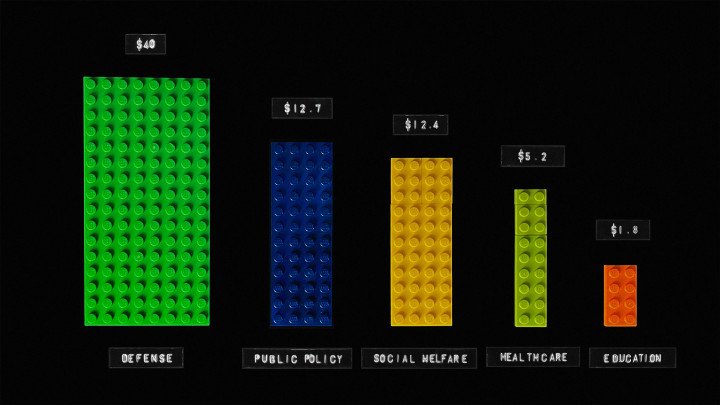- Category
- Life in Ukraine
Survival and Economic Development. What Does Ukraine Have in Its Wallet for 2024?

This year, Ukraine's state budget faces an unprecedented fiscal crisis. War has devastated the country’s economy, severely diminishing tax revenues. The urgent need to fund defence has also exacerbated the complicated situation Ukraine has found itself in. So what does Ukraine have in its wallet for 2024?
In the tranquil year of 2021, the freshly appointed Minister of Finance Serhiy Marchenko unveiled a budget brimming with promise, hailing it the ‘Budget of Opportunities for Development.’ Initially, the budget for 2022 was optimistically dubbed as the ‘Budget of Investments in People, Country, and Future.’ But as Ukraine spiraled into a brutal war, hopes for a clear future were dashed.
Russia’s full-scale invasion prompted a swift change to Ukraine's government budget designation. The narrative changed; with subsequent budgets bearing grim imprints of war, called the ‘Budget of Wartime,’ and reflecting the nation's aspirations for international support and stability.
Now a nation fighting for its very existence, Ukraine braces for its 2024 ‘Budget for Survival and Economic Development’—a fiscal plan tailored to ensure the country's economic resilience and growth despite the efforts of the enemy to undermine the plans.
From Hopes to Survival
Ukraine's state budget faces an unprecedented fiscal crisis. According to data from the government's official web portal, Open Budget, as of April 2024, expenditures have increased to UAH 3.4 trillion, which is 9% more than last year. With the Ministry of Finance's projected average exchange rate of 38.6 UAH/USD, Ukraine's expenditures in 2024 are estimated at around $88 billion.

Yet, domestic income will only be able to cover 1.8 trillion UAH, or around $47 billion. Whilst it is set to grow by 25% compared to 2023, outpacing the growth in expenditures — an unseen 50% gap remains in Ukraine’s budgeting. Past deficits pale in comparison, although the numbers are more optimistic than last year.
War has devastated the economy, severely diminishing tax revenues. Simultaneously, the urgent need to finance defense spending consumes vast resources, as Ukraine fights to recover its territories. With a strained budget, the state struggles to maintain crucial social services.
The Ministry of Finance faces a daunting task, heavily dependent on international assistance to maintain this fragile budget. Ukraine's domestic income will be directed towards security and defense budget.

Over half of the $12.4 billion in social welfare will directly fund pensions, a lifeline for the State Pension Fund. The loss of millions of taxpaying Ukrainians has dealt a devastating blow to the pension fund, rendering it increasingly dependent on external support. Consequently, the ability to provide pensions for millions of elderly citizens, a substantial demographic within the country, has become even more uncertain.
Surprisingly, Ukraine's colossal $40 billion defense budget also has a critical social component: over half of it provides salaries, medical care, and support to military families. Out of the $30 billion allocated to Ukraine's Ministry of Defense this year, $23 billion will be spent on salaries and medical care for the military.
Budgeting Complexity Amidst Warfare
An analysis of Ukraine's budget from 2021 to 2024 reveals a complex interplay of currency devaluation and wartime economic strain. While expenditures surged by over 40% in hryvnia during 2022, this increase lost significance due to a simultaneous devaluation of the currency.
Despite a degree of stabilization, the budget remains severely burdened with a sizable deficit, reflecting the sustained financial pressure on the nation. Beyond this, relentless inflation, exceeding 25% in 2022–2023 years, and currency devaluation have eroded savings and purchasing power. Though global, inflation hits Ukrainians especially hard, with their wallets already bearing the strain of war and a battered economy.
The National Bank has achieved a significant milestone, with the inflation rate falling below its target of 5%. Yet, forecasts warn that prices will soon begin climbing again.
Ukraine's budget for 2024 depends on its own resources and the help of its partners. Without a boost in international aid, the nation can only self-fund half its costs, prompting fears of severe cuts. While essential social programs may survive, critical progress could come to a standstill. Investments in weapons development, business support, and reforms – all engines of economic growth – may fall victim to austerity.
Plan B for Survival and Development
Still, the Ministry of Finance hints at a contingency plan. Ukraine scrambles to bridge its massive budget shortfall, turning to advance payments from state-owned companies and increasing domestic borrowing. Officials call the situation manageable, acknowledging a temporary reliance on internal funds.
While allies have pledged aid, the Ministry of Finance concedes that those funds won't arrive immediately. The critical concern now lies in the speed and consistency of those promised resources.
Desperate times fuel talk of heavier taxes and slashed spending behind closed doors. Though officially unconfirmed, this might become a reality if Ukraine won’t manage to survive solely on domestic funds. But against an aggressor with a vastly superior economy, the struggle to remain financially afloat grows increasingly dire.
Ukraine halted the risky practice of printing money to cover budget shortfalls in 2023. The National Bank expects to continue practicing its no-emission policy in 2024 – a relief after issuing 400 billion UAH in 2022. However, extreme financial need could force the Ministry of Finance to demand fresh currency, sparking renewed inflation and effectively placing a hidden tax on already strained Ukrainians.
Notably, nearly 90% of Ukraine's state budget comes from taxes paid by both individuals and businesses. These funds are crucial for the nation's defense, with contributions from sectors like agriculture, industry, and skilled labor playing a significant role.

According to the Ministry of Finance, Ukraine managed to raise about $10 billion in the first three months of 2024. This included $4.9 billion in concessional loans from the EU, $2.8 billion raised in the domestic market, $1.5 billion from Canada, as well as $1.1 billion in loans and grants from Japan, a $300 million grant from Norway, and a $3 million loan from Spain.
Drastic measures loom as Ukraine faces its fight for existence. As political delays choke off the billions in vital international aid, the desperate reality sets in: harsh cuts and even hidden taxes may be the only path to survival and economic development.


-f88628fa403b11af0b72ec7b062ce954.jpeg)

-24deccd511006ba79cfc4d798c6c2ef5.jpeg)

-73e9c0fd8873a094288a7552f3ac2ab4.jpg)

-554f0711f15a880af68b2550a739eee4.jpg)